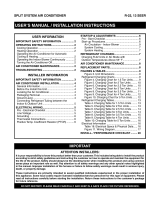
7
REFRIGERANT CHARGING
WARNING:
*SA1QE4M1SN Split System Air Conditioners
are shipped charged with R410A refrigerant
and ready for installation. If repairs make it
necessary for evacuation and charging, it should
only be attempted by qualified trained personnel
thoroughly familiar with this equipment. Under
no circumstances should the owner attempt to
install and/or service this equipment. Failure to
comply with this warning could result in property
damage, personal injury, or death.
• After refrigerant line connections are completed, it is
required that you leak check and evacuate the indoor
section and all line connections (using proper methods)
before finalizing the full system refrigerant charge.
• To achieve rated capacity and efficiency, the compressor
must be exposed to refrigerant for at least 24 hours prior
to running and then the compressor must be run for a
minimum of 12 hours.
• The refrigerant charging charts are applicable only to
matched assemblies of this equipment and listed airflows
for the indoor coil. If system is matched with an indoor unit
that has a restrictor, refer to Table 4, (page 8), Table 5,
(page 8), Table 6, (page 9), Table 7, (page 9),
Table 8, (page 10), & Table 9, (page 10) for correct
system charging. If system is matched with an indoor unit
that has a TXV, refer to Figure 4, (page 11).
• Refer to the unit's Quick Reference Data sheet to
determine if additional refrigerant will need to be
weighed-in to attain the base refrigerant amount
for the system match that is being installed. Please
note that the charge additons provided in the QRD
are estimates based on test data and should only be
used as a starting point. Complete the steps in the
charging procdure to obtain the final system charge.
• Use of SA1QE4M1SN outdoor units with non-AHRI listed
indoor coils are not recommended and deviations from rated
airflows or non-listed combinations may require modification
to the expansion device and refrigerant charging procedures
for proper and efficient system operation.
• The refrigerant charge can be checked and adjusted through
the service ports provided external to the outdoor unit. Use
only gage line sets which have a “Schrader” depression
device present to actuate the valve.
• A high-pressure switch is factory-installed and located in
the liquid line internal to the outdoor unit. The switch is
designed to protect the system when very high pressures
occur during abnormal conditions. Under normal conditions,
the switch is closed. If the liquid pressure rises above 575
psig, then the switch will open and de-energize the outdoor
unit. The switch will close again once the liquid pressure
decreases to 460 psig. Please note that the switch interrupts
the thermostat inputs to the unit. Thus, when the switch
opens and then closes, there may be a 5 minute short
cycling delay before the outdoor unit will energize.
Charging the Unit in AC mode (TXV Matches)
(With outdoor temperatures above 65° F)
1. With the system operating at steady-state, measure the
liquid refrigerant pressure (in psig) at the outdoor unit
service valve.
2. Measure the liquid refrigerant temperature (in Fahrenheit)
at the service valve.
3. Determine the required liquid refrigerant pressure from
Figure 4, (page 11).
• If the pressure measured in Step 1 is greater than
the required liquid refrigerant pressure determined in
Step 3, then there is too much charge in the system.
Remove refrigerant and repeat Steps 1 through 3 until
the system is correctly charged.
• If the pressure measured in Step 1 is less than the
required liquid refrigerant pressure determined in
Step 3, there is too little charge in the system. Add
refrigerant and repeat Steps 1 through 3 until the
system is correctly charged.
Charging Charts & Application Notes
(Cooling Mode Only)
• This unit’s cooling system contains refrigerant under
high pressure. Always use safe and environmentally
sound methods when handling refrigerant handling
or servicing the unit. Review the factory literature and
safety warnings prior to servicing.
• When repairing system leaks, always use a nitrogen (inert)
gas to protect the refrigerant system and pressure check the
repair before re-charging. Always replace the filter-dryers
when performing any repair to the refrigeration system with
one capable of acid removal. After completing the repairs,
evacuate the system to 350 - 500 microns and weigh in
the refrigerant to the amount specified on the unit rating
label.
• The charging charts are valid for a variety of indoor, return
air conditions and are most influenced by the outdoor
ambient temperature, outdoor fan operation and the unit
operating voltage.
• Before using the charging charts, make sure the unit is
in a stable operating mode. As shown in Figure 4, (page
11), the ideal system sub-cooling can vary over the
range of operation. Reference the chart to determine the
ideal amount of sub-cooling for a given liquid pressure.
Units charged to other values will not perform at the rated
unit efficiency (EER) or rated Coefficient of Performance
(COP) in heating mode.
• To inspect a systems operation using quality instruments,
match the measured liquid temperature to the units table.
The measured liquid pressure reading should be within
3% of the table value for most installations.
• For systems that are operating with more than a 5%
deviation, inspect the unit for the proper voltage and phase
balance and the refrigeration system for leaks.
• Units that are operating at less then 95% of the nominal
voltage or with a 2% phase imbalance may see a more
significant deviation than the amount stated above.
• DO NOT use the charts in systems that have a fan cycling
under low-ambient control. Refer to the low-ambient kit
instructions for more information (If applicable).
















